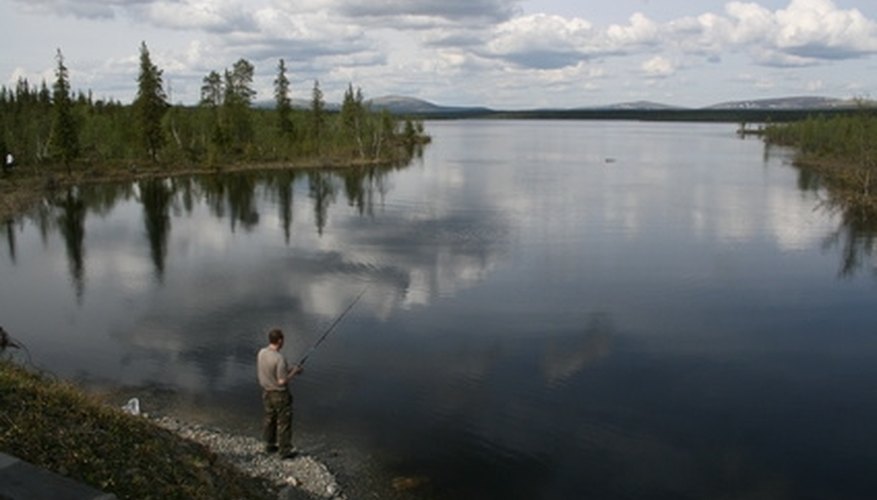
When you go fishing, there are a few things to take care of before you can start catching fish. First an foremost, your fishing line must be set up. Not only must your line be attached to the rod and reel, it also must have an artificial lure or live-bait rig attached to it. Once you have your equipment set up, then it is time to go fishing.
Items you will need
Fishing rod and reel
Fishing line
Lures
Sinkers
Hooks
Bobbers
Swivels
Scissors
Select the fishing reel on which you plan to spool the line. If you opt for a spinning reel (one with an exposed spool and that hangs below the rod), select a spinning rod to go with it. A spinning rod is one that does not have a piece shaped like a trigger that hangs off the rod underneath the handle. If you opt for a baitcasting reel (the spool on such a reel is visible, but inside the reel, and the reel itself sits on top of the fishing rod), select a baitcasting rod, which is one that has the trigger on the rod handle.
Spool line onto the reel. Thread the line through the tip of the fishing rod, and then through each of the line guides on the rod until you make your way down to where the reel is attached to the rod. Once the end of the line is at the reel, wrap the line two times around the spool of the reel. Tie a knot in the line so it holds itself tightly against the spool, and then snip all 1/8 of an inch of the extra line that extends above the knot. To add line, turn the reel handle as if reeling in a fish. Stop reeling when the fishing line is 1/8 of an inch below the rim of the reel spool. Cut the line with a scissors so that about a foot of line hangs beyond the tip of the rod.
Decide how you want to rig your fishing line, based on what fish species you plan to target. Your two choices are an artificial lure or a live-bait rig. Anglers who use live bait--like those who target walleyes, crappies and sunfish--should opt for the latter. Fishermen who primarily fish for bass, muskellunge and northern pike generally opt for artificial baits.
Tie on a live-bait rig, if that is what you decided to use. The main rigs you can choose are bobber rigs and Lindy rigs. A Lindy rig is particularly well suited for walleye fishing, and includes--in order--a sliding sinker, swivel, leader, and hook. A piece of live bait (leech, minnow, or nightcrawler) rounds out the presentation. A bobber rig is oftentimes the rig that beginning anglers use, since it alerts them when a fish is biting. The rig consists, in order, of a bobber, sinker, and hook. The bobber should be set so it will suspend your hook about 12 to 24 inches off the bottom.
Tie a snap swivel to the end of your line if you plan to use artificial baits. The snap swivel allows you to change baits as often as you like, without cutting your line and retying it. If you do not plan to change baits much, you can get away with not using a swivel and instead tying the lure directly to the end of your line.
References
Writer Bio
Larry Anderson has been a freelance writer since 2000. He has covered a wide variety of topics, from golf and baseball to hunting and fishing. His work has appeared in numerous print and online publications, including "Fargo Forum" newspaper. Anderson holds a Bachelor of Arts in print journalism from Concordia College.



